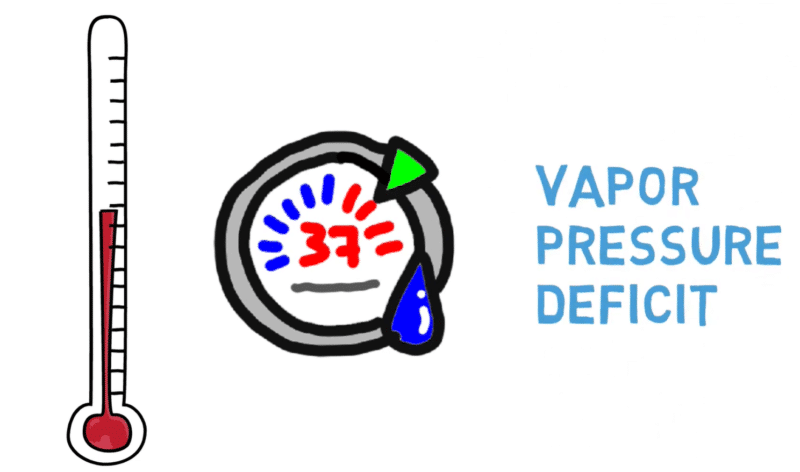Understanding the Importance of VPD Design and HVAC
July 2, 2020 / 6 mins read

VPD stands for ‘Vapor Pressure Deficit’ which is the difference between the moisture found in the air and how much moisture the air can hold before it becomes fully saturated. Basically, think of VPD as the parameters involved in the transpiration of moisture created by plants. Within a cultivation space, VPD denotes the temperature and humidity of the area. For your plants to flourish, you need to maintain the correct VPD to keep your crop healthy. The process of transpiration refers to the migration of water and nutrients from the plant’s root zone up through the plant’s vascular system. If an excessive amount of transpiration occurs or it is too little, then the plant can suffer damage. Watch our brief video below, then continue reading to learn more!
Maintaining the Optimal VPD
It might sound like an easy task to maintain the optimal VPD but there are no set parameters. Depending on what crops you are cultivating, you can find various models. With tomatoes, most growers prefer 0.6 and 1.1 kPa in sun and during the night 0.4 – 0.7 kPa if the plants are in the vegetative state. Then the parameters change to d 0.6 – 1.4 kPa in the sun during the fruiting and flower cycles. This means that the optimum runs from 1.2-1.5 kPa according to the most accepted online charts. However, other factors are involved with the humidity and temperature that create crucial responses in a plant that is completely independent of VPD. Also, you must determine the grow rooms setpoints to outweigh the possible microbial proliferation that can occur. Basically, VPD Is an important parameter that all growers should consider but it is not the only one. Any time you cultivate inside of a facility, you must take into consideration all factors to create homeostasis for the health and well-being of your plants.
Understanding Temperature and Humidity
One of the key components of HVAC design for cultivation facilities involves cooling the space. Calculations are used to determine the required cooling load. In addition, dehumidification is also important and a little more complex for load calculation. To identify dehumidification requirements, we must look at the dewpoint temperature desired by the client. Dewpoint is the temperature where water condenses from vapor into liquid so it can be effectively collected and removed. Dewpoint, just like VPD, is also a setpoint for temperature and humidity within the space which sets into motion the evapotranspiration to set the rate of dehumidification that can be successfully achieved by the HVAC system.
Of importance to note is the complicated dynamics involved in temperature and humidity. The entire crop that you are cultivation relies on the accuracy of predicting and maintaining very precise climate setpoints, so it is a necessity to understand all things involved in the process. At Mintropy, we are HVAC professions who understand and rely on the Psychometric Chart to accurately visualize the air’s thermodynamic properties. Two of our specialties involve maintaining the correct parameters needed in cultivation spaces while continuing to understand the plants growth dynamics that occur and evolve in a controlled environment.
Applying VPD
Let us take a moment to look at the HVAC perspective involving VPD. Basically, the lower the dewpoint temperature = the less dehumidification attainable by the HVAC equipment. Even if there is the same amount of water in the grow space, if the dewpoint temperature is lower than the space will require more equipment to successfully achieve the needed checkpoints. Obviously, these considerations have an impact on your overhead and operating expenses. As most growers know, your climate control system is one of the largest expenses you will face when constructing a new facility or updating an older space. Monthly energy use must also be factored in. Remember, everything is about balance when it comes to temperature, humidity, and VPD.
Additional Considerations Concerning
Depending on the system, we can often increase the air handling capacity without factoring in the overall compressor and BTU capacity. However, they must also be increased to parallel each other. Obviously, this upsurges the operating costs and capital needed. In systems that do not have dehumidification and cooling integrated (such as with stand-alone dehumidification) things will remain consistent because the space requires more dehumidifiers and additional cooling to offset the heat produced by the dehumidifiers. As you can see from this example, all situations are unique and Mintropy is here to tackle and handle each challenge presented by your grow operation.
At Mintropy, we know that cultivation design is complicated, but we have the information that cultivators seek. We know that temperature and humidity are factors that must be weighed independently and that calculations often vary dramatically depending on the facility’s location and equipment being used. We are ready to provide the data so you can add it to your decision-making arsenal, and we can start saving you money will optimizing your grow operation to produce a robust harvest.
Need help with your project? Let’s get in touch!
Lorem ipsum dolor sit amet, consectetuer adipiscing elit.


